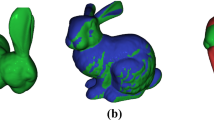Abstract
This paper presents Planar Fitting Transformation (PFT), a highly efficiency-oriented 3D point cloud registration. Based on Normal Distribution Transformation (NDT), we replace the gaussian approximation with least-squared planar fitting, dramatically increasing the FPS to 500 Hz with CPU (18 threads). As an alternative to the time-consuming neighbor search, we propose octomerge voxelization to enhance robustness without compromising efficiency. As a result, our work significantly outperforms all state-of-the-art methods in execution time, while retaining a comparable level of accuracy.
Access this chapter
Tax calculation will be finalised at checkout
Purchases are for personal use only
Similar content being viewed by others
Notes
- 1.
GitHub repository: https://github.com/Leohsieh57/pft_matcher.
- 2.
Since \(\textbf{T}_0\) also denotes the Taylor expansion point, although less consistent with (1), we alternatively denote the initial guess by \(\textbf{T}_{init}\) to avoid confusion.
- 3.
GitHub repository: https://github.com/koide3/ndt_omp.
- 4.
GitHub repository: https://github.com/SMRT-AIST/fast_gicp.
- 5.
The common suffix -10k is omitted.
References
Barnes, D., Gadd, M., Murcutt, P., Newman, P., Posner, I.: The oxford radar robotcar dataset: a radar extension to the oxford robotcar dataset. In: Proceedings of the IEEE International Conference on Robotics and Automation (ICRA), Paris (2020)
Bentley, J.L.: Multidimensional binary search trees used for associative searching. Commun. ACM 18(9), 509–517 (1975)
Besl, P., McKay, H.D.: A method for registration of 3-d shapes. IEEE Trans. Pattern Anal. Mach. Intell. 14, 239–256 (1992)
Geiger, A., Lenz, P., Urtasun, R.: Are we ready for autonomous driving? the kitti vision benchmark suite. In: Conference on Computer Vision and Pattern Recognition (CVPR) (2012)
Horn, B.: Closed-form solution of absolute orientation using unit quaternions. J. Opt. Soc. A 4, 629–642 (1987)
Kato, S., Takeuchi, E., Ishiguro, Y., Ninomiya, Y., Takeda, K., Hamada, T.: An open approach to autonomous vehicles. IEEE Micro 35(6), 60–68 (2015)
Koide, K., Yokozuka, M., Oishi, S., Banno, A.: Voxelized gicp for fast and accurate 3D point cloud registration. In: 2021 IEEE International Conference on Robotics and Automation (ICRA), pp. 11054–11059 (2021)
Rusinkiewicz, S., Levoy, M.: Efficient variants of the icp algorithm. In: Proceedings Third International Conference on 3-D Digital Imaging and Modeling, pp. 145–152 (2001)
Rusu, R.B., Blodow, N., Beetz, M.: Fast point feature histograms (fpfh) for 3D registration. In: 2009 IEEE International Conference on Robotics and Automation, pp. 3212–3217 (2009)
Segal, A., Hähnel, D., Thrun, S.: Generalized-icp (2009)
Serafin, J., Grisetti, G.: Nicp: dense normal based point cloud registration. In: 2015 IEEE/RSJ International Conference on Intelligent Robots and Systems (IROS), pp. 742–749 (2015)
Stoyanov, T., Magnusson, M., Andreasson, H., Lilienthal, A.: Fast and accurate scan registration through minimization of the distance between compact 3D NDT representations. Int. J. Rob. Res. 31, 1377–1393 (2012)
Streiff, D., Bernreiter, L., Tschopp, F., Fehr, M., Siegwart, R.: 3d3l: deep learned 3D keypoint detection and description for lidars. In: 2021 IEEE International Conference on Robotics and Automation (ICRA), pp. 13064–13070 (2021)
Sturm, J., Engelhard, N., Endres, F., Burgard, W., Cremers, D.: A benchmark for the evaluation of rgb-d slam systems. In: Proceedings of the International Conference on Intelligent Robot Systems (IROS) (2012)
Author information
Authors and Affiliations
Corresponding author
Editor information
Editors and Affiliations
Appendices
A Experiment Configurations
1.1 A.1 GPS/INS Interpolation
Let \(\textbf{T}_t\) denote the INS pose at time t, for an instance \(\beta \) between two consecutive INS occurrences \(\textbf{T}_\alpha \) and \(\textbf{T}_\gamma \), the interpolation \(\textbf{T}_\beta \) is:
A LiDAR scan would be excluded from RobotCar (INS) if it arrives after the last or before the first INS instance, since \(\alpha \le \beta \le \gamma \) no longer holds.
1.2 A.2 Configuration Details
Source clouds are downsampled by voxel-grid filters with grid size listed in Table 2. Initial guesses \(\textbf{T}_{init}\) are generated according to (13), except for RobotCar (INS), which uses (17) instead.
B Tested Sequences of Datasets
1.1 B.1 RobotCar

1.2 B.2 KITTI
Sequence 00-10, all sequences with public ground truth.
1.3 B.3 TUM-RGBD

Rights and permissions
Copyright information
© 2023 The Author(s), under exclusive license to Springer Nature Switzerland AG
About this paper
Cite this paper
Hsieh, W. (2023). Planar Fitting Transformation: A Rapid Point Cloud Registration for Real-time Applications. In: Jo, J., et al. Robot Intelligence Technology and Applications 7. RiTA 2022. Lecture Notes in Networks and Systems, vol 642. Springer, Cham. https://doi.org/10.1007/978-3-031-26889-2_23
Download citation
DOI: https://doi.org/10.1007/978-3-031-26889-2_23
Published:
Publisher Name: Springer, Cham
Print ISBN: 978-3-031-26888-5
Online ISBN: 978-3-031-26889-2
eBook Packages: Intelligent Technologies and RoboticsIntelligent Technologies and Robotics (R0)




